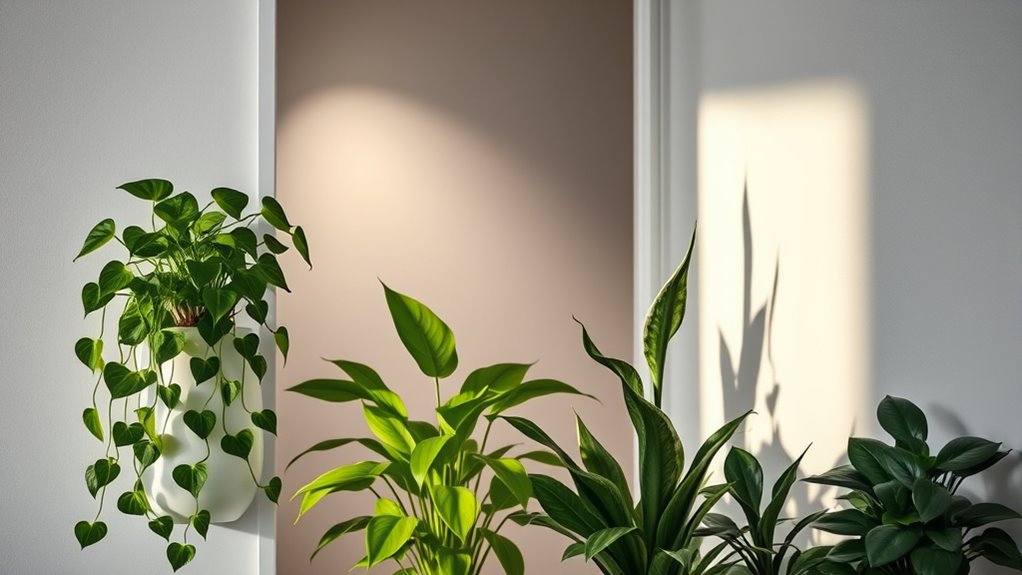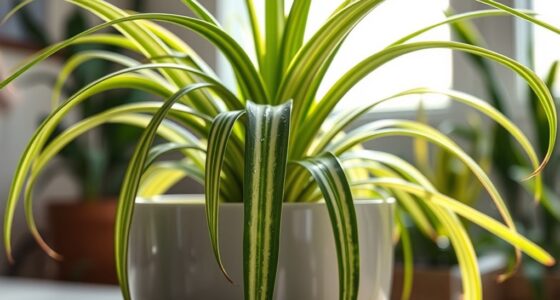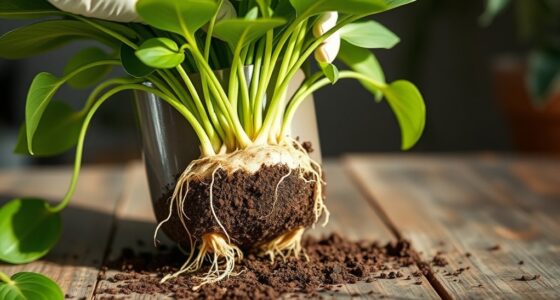If you’re looking to brighten a windowless room, choose low-light plants that thrive in minimal or artificial light. Consider snake plants, ZZ plants, pothos, peace lilies, or cast iron plants—they’re tough, need little water, and tolerate neglect. Chinese evergreens, dracaenas, parlor palms, and dumb canes also work well for dark spaces. Want to discover more tips on caring for these resilient plants? Keep exploring to transform your space effortlessly.
Key Takeaways
- Suitable low-light plants include Snake Plant, ZZ Plant, Pothos, Peace Lily, and Cast Iron Plant.
- These plants tolerate minimal or artificial light, making them ideal for windowless or dark rooms.
- Use well-draining soil and avoid overwatering to prevent root rot and maintain plant health.
- Many low-light plants, like Pothos and Peace Lily, also improve indoor air quality.
- Regular maintenance such as pruning and leaf cleaning helps keep these resilient plants thriving indoors.
Snake Plant (Sansevieria)
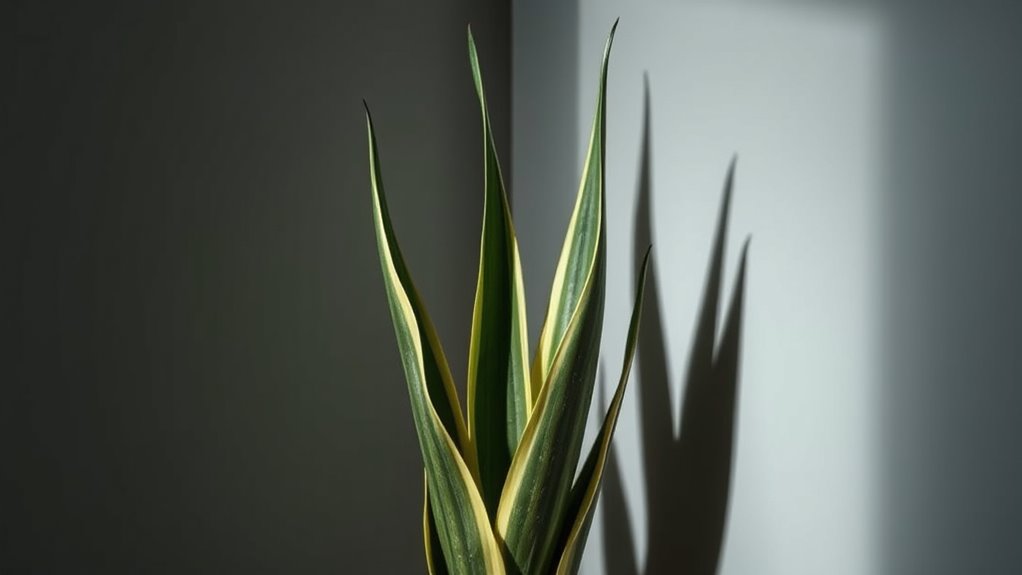
Even in low-light conditions, the Snake Plant (Sansevieria) thrives, making it an ideal choice for windowless rooms. It tolerates minimal lighting, so you don’t need to worry about direct sunlight. When it comes to soil requirements, use well-draining soil, like cactus or succulent mix, to prevent root rot. Snake Plants prefer slightly dry conditions, so avoid overwatering; let the soil dry out completely between waterings. This plant’s hardy nature means it can adapt to various indoor lighting setups, but it performs best in moderate to low light. Make certain your pot has drainage holes to avoid excess moisture. Regular tuning of your plant’s watering schedule can help maintain its health and vibrancy. With the right soil and lighting conditions, your Snake Plant will stay healthy and vibrant with minimal fuss.
ZZ Plant (Zamioculcas Zamiifolia)
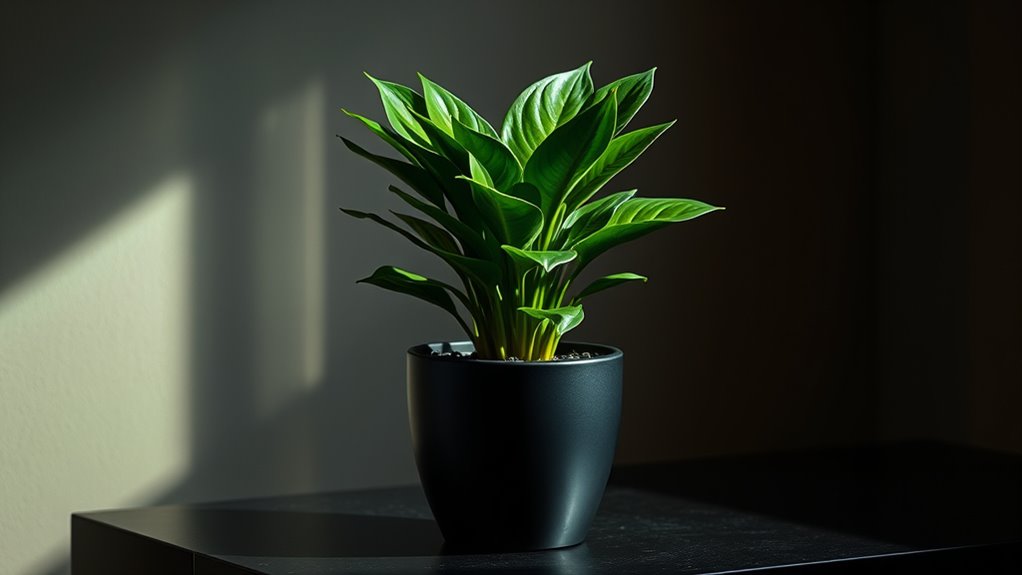
The ZZ Plant (Zamioculcas zamiifolia) is an excellent choice for windowless rooms because it thrives in low-light conditions and requires minimal maintenance. It adapts well to indoor humidity levels and can tolerate neglect, making it ideal for busy spaces. To help your ZZ plant flourish, consider sunlight alternatives like fluorescent or LED grow lights if natural light is scarce. Maintaining proper indoor humidity ensures healthy growth, preventing leaf tip browning. Here’s a quick guide to understanding its needs:
| Aspect | Preference | Tips |
|---|---|---|
| Light | Low-light, sunlight alternatives | Use grow lights if necessary |
| Watering | Infrequent, allow soil to dry | Water sparingly, avoid overwatering |
| Humidity | Moderate indoor humidity | Use a humidifier if air is dry |
| Soil | Well-draining | Use cactus or succulent mix |
| Maintenance | Minimal | Wipe leaves, prune dead stems |
Pothos (Epipremnum Aureum)
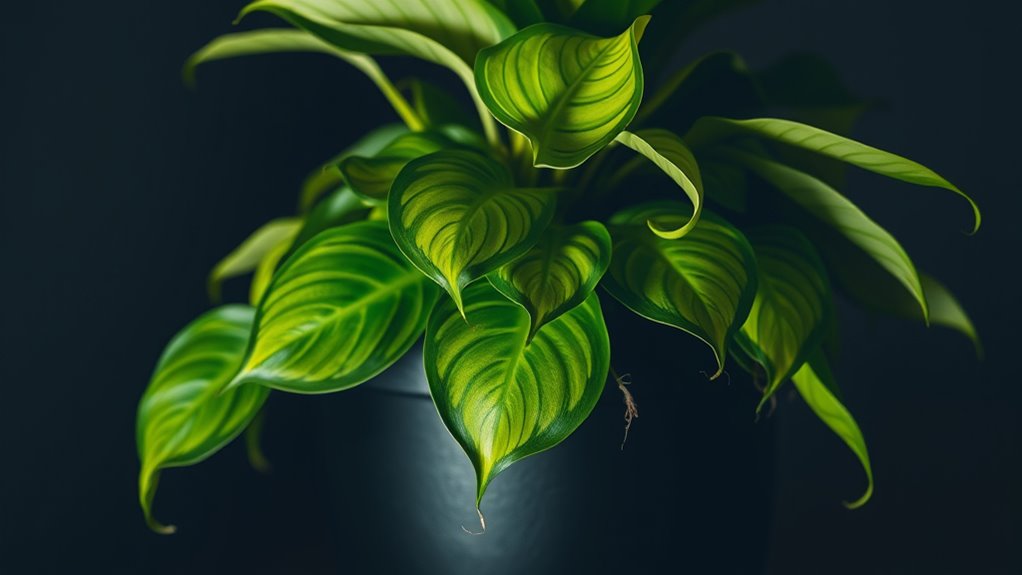
Pothos plants bring vibrant, green foliage even in low-light conditions, brightening up windowless spaces. They’re incredibly easy to care for and require minimal maintenance, making them perfect for busy schedules. Plus, their air-purifying qualities help improve your indoor environment effortlessly. Regularly pruning your pothos can promote healthier growth and prevent overgrowth, especially in confined spaces. Toilet maintenance knowledge can help you understand how to care for your plants better and troubleshoot any issues that arise.
Vibrant Foliage Despite Darkness
Although low light can make many plants struggle, Pothos (Epipremnum aureum) thrives in such conditions, displaying vibrant, lush foliage. Its rich green leaves with splashes of yellow add life to any space, even in windowless rooms. This plant’s resilience makes it ideal for offices, bathrooms, or dark corners. You can incorporate its striking leaves into flower arrangements or use it to brighten indoor gardening projects. Its adaptability also makes it perfect for outdoor gardening in shaded areas. Pothos’s vibrant foliage proves that darkness doesn’t mean dullness. With minimal care, you’ll enjoy its lush appearance without worry. Its hardy nature ensures your space stays lively and inviting, transforming dull corners into vibrant retreats. Additionally, its low-maintenance nature makes it suitable for beginners and busy households alike.
Easy Care and Maintenance
You’ll find that caring for Pothos is straightforward and forgiving, making it perfect for beginners or busy spaces. Its low-maintenance nature means you don’t need a strict watering schedule; simply water when the top inch of soil feels dry. Pothos thrives in well-draining soil, so use a mix that prevents water from sitting around the roots. This plant is tolerant of occasional neglect, so you don’t have to worry about overwatering or perfect conditions. Regularly wipe the leaves to keep dust-free and encourage healthy growth. Pothos can adapt to various indoor environments, making it an ideal low-light plant for windowless rooms. Incorporating proper lighting or supplemental grow lights can help enhance its growth and vitality with minimal effort, so you’ll enjoy its vibrant foliage without the hassle of complicated care routines.
Air Purifying Benefits
Because of its natural ability to filter indoor air, Pothos (Epipremnum aureum) is an excellent choice for improving air quality in windowless rooms. This plant actively reduces airborne toxins and VOCs, making your environment healthier. Its leaves absorb pollutants, helping to clear out harmful chemicals and improve overall air quality. Pothos is especially effective at VOC removal, which is common in enclosed spaces with limited ventilation. By adding this low-light plant, you create a cleaner, fresher indoor atmosphere. Remote work environments can benefit significantly from incorporating air-purifying plants like Pothos to support well-being and productivity in confined spaces.
Peace Lily (Spathiphyllum)
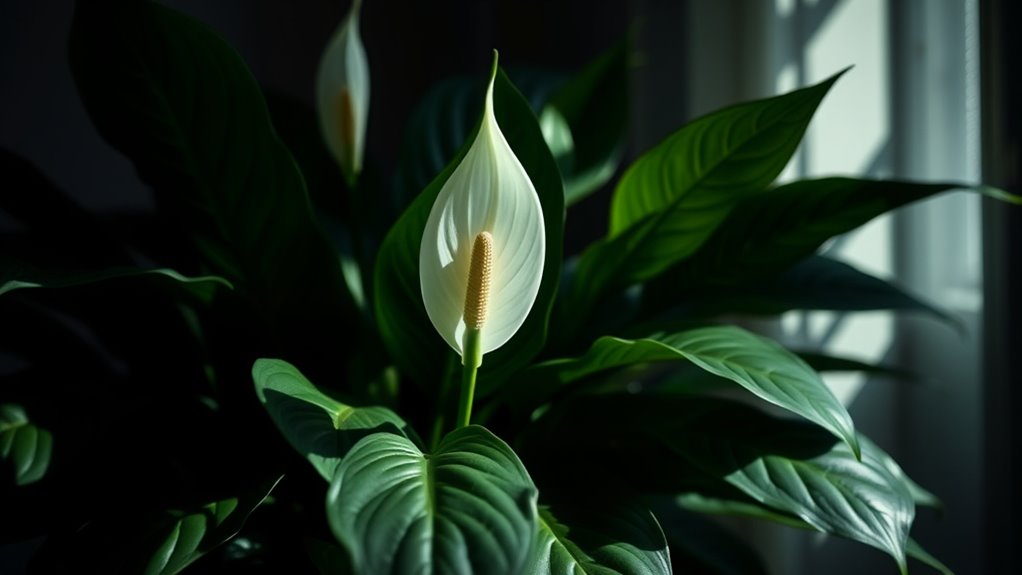
The Peace Lily thrives in low-light conditions and is surprisingly easy to care for, making it perfect for windowless rooms. Its beautiful white blooms add a touch of elegance, while it also helps improve indoor air quality. If you’re looking for a low-maintenance plant with air-purifying benefits, the Peace Lily is an excellent choice. Additionally, its resilience can symbolize the strength needed to navigate trust issues in relationships.
Low Light Tolerance
Peace lilies (Spathiphyllum) are well-suited for low-light environments because they can thrive in shaded areas with minimal sunlight. Their low light tolerance means you don’t need to place them near windows or in bright spots. Instead, focus on lighting options that suit their needs and plant placement that minimizes direct sun exposure. These plants can handle fluorescent or indirect light, making them versatile for windowless rooms. To optimize their health, consider the following:
- Position them away from direct sunlight, such as under artificial lighting
- Use shaded corners or areas with ambient light
- Avoid placing them in spots with drafts or temperature fluctuations
- Understanding plant light requirements can help you better care for your peace lily and ensure it thrives even in less-than-ideal lighting conditions.
Easy to Care For
One of the main reasons peace lilies are popular as low-light plants is their ease of care. They require minimal attention and adapt well to indoor conditions, making them ideal for windowless rooms. When it comes to lighting considerations, peace lilies thrive in low to medium indirect light, so you don’t need to worry about perfect sunlight exposure. They also have natural pest resistance, which helps with pest prevention—simply keep an eye out for common issues like spider mites or aphids. Water your peace lily when the top inch of soil feels dry, and avoid overwatering to prevent root rot. Regularly wipe its leaves to keep dust off, promoting healthy growth and making care even easier. Overall, these plants are low-maintenance and forgiving, perfect for beginners. Proper storage conditions can also extend their lifespan and keep them looking vibrant.
Air Purifying Benefits
Since peace lilies are easy to care for and thrive in low-light environments, they also provide significant air-purifying benefits. They help improve indoor air quality by removing toxins like formaldehyde, xylene, and ammonia. As they do this, they naturally boost indoor humidity levels, creating a more comfortable environment. Additionally, healthy peace lilies can help prevent pests by maintaining proper moisture and cleanliness. To maximize their benefits, assure you keep the soil moist but not soggy, supporting pest prevention. Regularly removing dead leaves also reduces pest attraction. Proper plant care is essential for maintaining their air-purifying efficiency and overall health. Here are some key benefits:
- Removes indoor air toxins effectively
- Enhances indoor humidity levels
- Supports pest prevention by maintaining healthy foliage
Cast Iron Plant (Aspidistra Elatior)
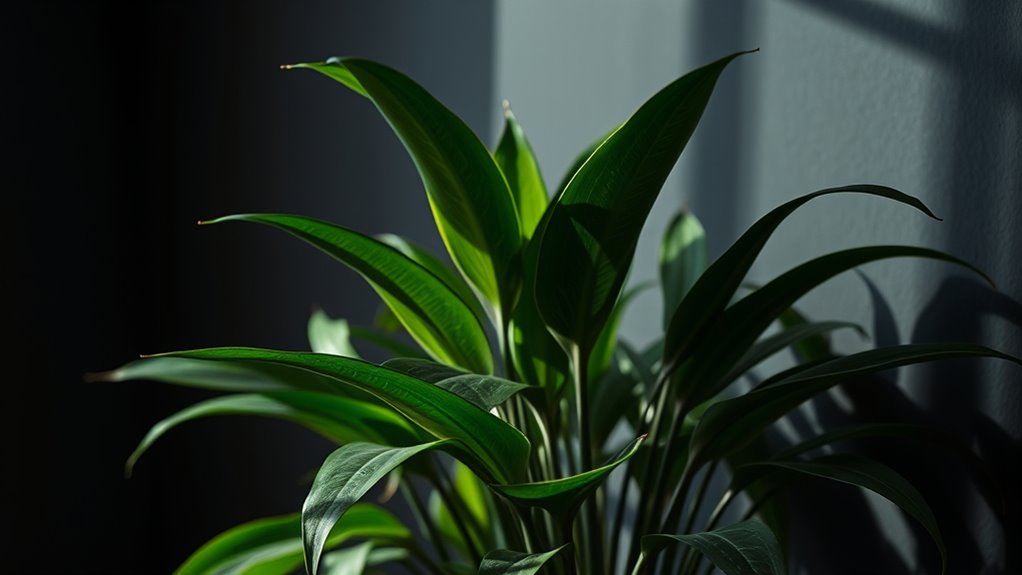
The Cast Iron Plant (Aspidistra Elatior) is an excellent choice for windowless rooms because it thrives in low-light conditions and requires minimal care. To keep it healthy, you can easily propagate it through division or potted cuttings, which helps you expand your indoor greenery. Its tough nature makes pest management simple—regularly inspect for scale or spider mites, but infestations are rare. If pests appear, wipe leaves with a damp cloth or use natural insecticides. The plant’s resilience means you don’t need frequent watering; let the soil dry out between drinks. Its hardy nature makes it perfect for low-maintenance spaces, ensuring your room stays lush and green without much effort. Just remember, minimal care and vigilant pest management will keep your cast iron plant thriving. Additionally, understanding ethical hacking principles can help you better protect your digital assets while managing your home environment securely.
Philodendron (Philodendron Spp.)
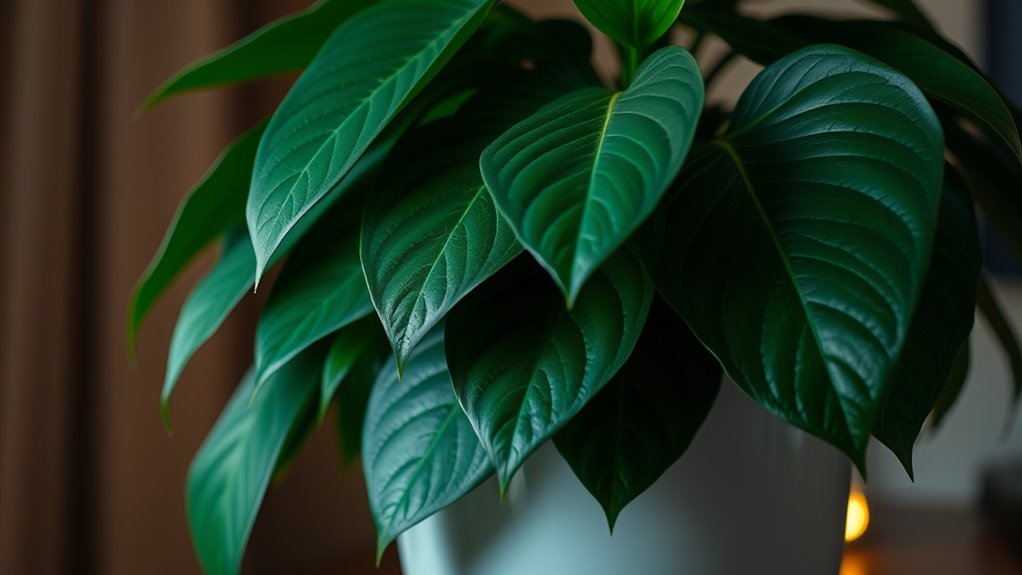
A philodendron is an ideal plant for windowless rooms because it thrives in low-light environments and requires minimal care. Its adaptable nature makes it perfect for indoor spaces with limited natural light. To keep your philodendron healthy, consider these tips:
- Lighting options: It tolerates low to moderate indirect light, but avoid direct sunlight to prevent leaf burn.
- Watering: Water when the top inch of soil feels dry; overwatering can lead to root rot.
- Pest management: Watch for common pests like spider mites and mealybugs, and treat promptly with insecticidal soap or neem oil.
With proper care and attention to lighting and pests, your philodendron will flourish and add lush greenery to your windowless space.
Chinese Evergreen (Aglaonema)
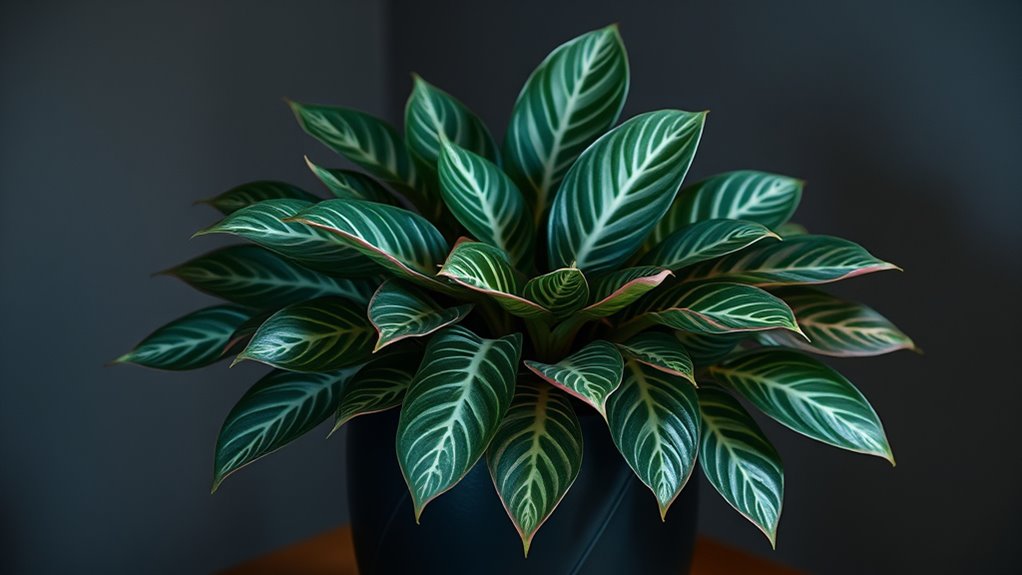
Chinese Evergreen (Aglaonema) is an excellent choice for windowless rooms because it thrives in low-light conditions and requires minimal maintenance. Its broad leaves maximize light absorption, allowing it to make the most of limited ambient light. This plant’s ability to adapt to low light makes it ideal for dim environments. Additionally, its shallow root depth means you won’t need frequent repotting or deep containers, simplifying care. You can place it on desks, shelves, or corners without worrying about extensive watering or sunlight. The plant’s resilience and attractive foliage add a splash of greenery to otherwise dull spaces. Overall, Chinese Evergreen offers an easy, low-maintenance solution for bringing life to windowless rooms without sacrificing style or health.
Dracaena (Dracaena Spp.)
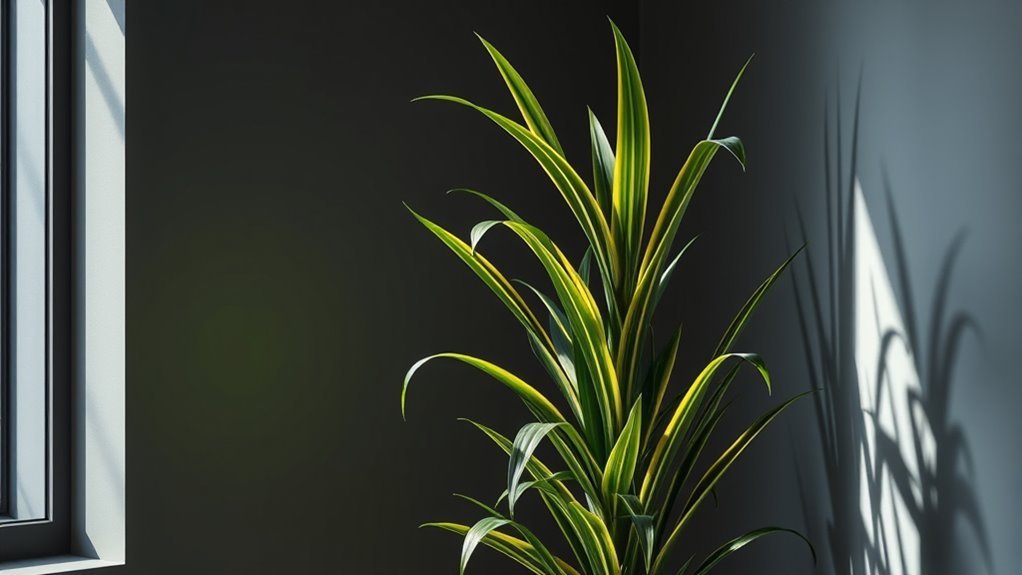
Dracaena species are popular choices for windowless rooms because they tolerate low light better than many other indoor plants. They add height and greenery without demanding much attention, making them ideal for darker spaces. To keep your dracaena thriving, you can encourage healthy root development through simple plant propagation methods like stem cuttings. This process helps you expand your indoor garden easily. You’ll notice roots forming within a few weeks, signaling successful propagation. Here are some key tips:
- Use sharp, clean tools for cuttings
- Keep soil slightly moist but not waterlogged
- Place cuttings in indirect light to promote root development
With minimal care, dracaenas remain hardy and resilient, transforming even the dimmest rooms into lush green retreats.
Parlor Palm (Chamaedorea Elegans)
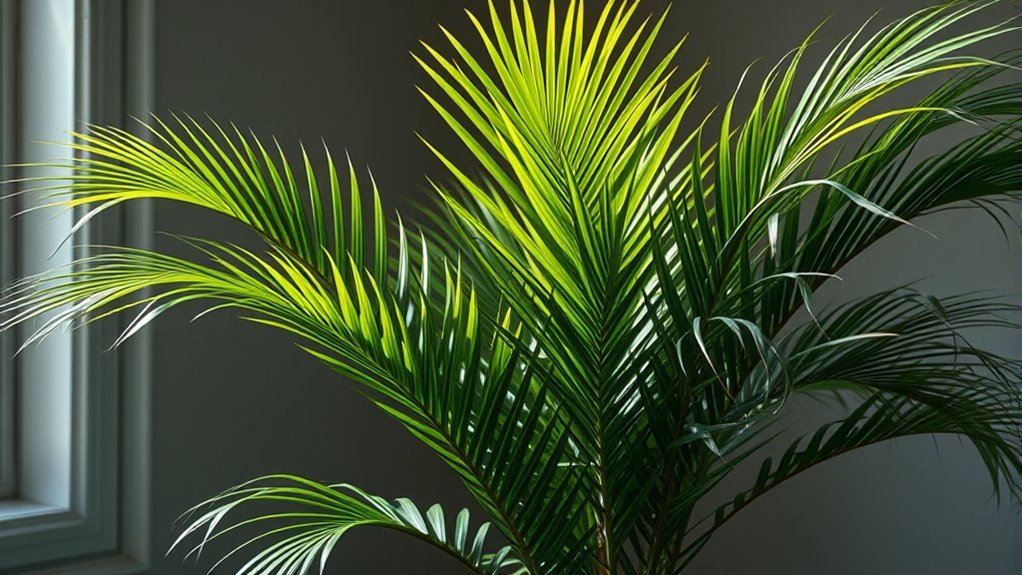
The Parlor Palm (Chamaedorea elegans) is an excellent choice for windowless rooms because it tolerates low light conditions exceptionally well. It thrives in indoor humidity levels, making it perfect for enclosed spaces with less airflow. This palm grows at a moderate rate, so you won’t need to worry about frequent repotting or pruning. To keep it healthy, maintain consistent moisture in the air—mist the leaves or use a humidifier if the air feels dry. Its lush, feathery fronds add a touch of greenery without demanding much sunlight. Because of its adaptability to low light and humidity, the Parlor Palm is a low-maintenance, stylish option that will flourish in your dimly lit rooms.
Dumb Cane (Dieffenbachia)
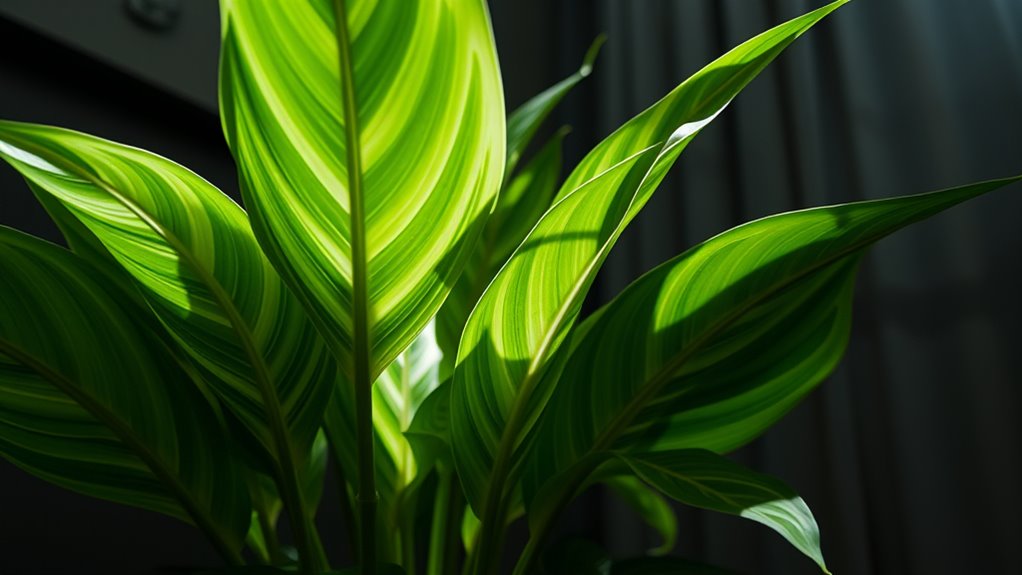
Dumb Cane (Dieffenbachia) can tolerate lower light levels, but understanding its brightness tolerance helps you keep it healthy. Proper care and maintenance are essential, especially in windowless rooms, to prevent issues like leaf browning or drooping. Keep these tips in mind to ensure your plant thrives in dim conditions.
Brightness Tolerance Levels
While Dumb Cane (Dieffenbachia) isn’t the most demanding plant when it comes to light, it still needs a certain level of brightness to thrive. Ideally, it prefers bright, indirect sunlight, but it can adapt to low-light conditions. Keep in mind that too little light may cause the leaves to lose their vibrant color and grow leggy. To support healthy growth, maintain proper indoor humidity, which helps prevent pests and diseases.
Here are some brightness tolerance tips for your Dumb Cane:
- It can survive in low to medium light but thrives in brighter, indirect light.
- Avoid direct sunlight, which can scorch its leaves.
- Rotate the plant regularly to ensure even light exposure.
Care and Maintenance Tips
To keep your Dumb Cane healthy and vibrant, you should establish a consistent care routine that includes proper watering, pruning, and positioning. Use lighting techniques that maximize its growth, such as placing it in a spot with indirect light, even in low-light rooms. While it tolerates minimal sunlight, avoid direct exposure that can scorch its leaves. Stick to a watering schedule that keeps the soil evenly moist but not waterlogged; typically, watering once a week suffices, adjusting based on humidity and temperature. Regular pruning helps maintain its shape and removes any yellowing leaves. Remember, overwatering can cause root rot, so always check the soil’s dryness beforehand. Proper care will guarantee your Dumb Cane remains lush and healthy despite the low-light environment.
Frequently Asked Questions
Which Low-Light Plants Are Safest for Households With Pets?
When choosing plants for a household with pets, you want pet-safe foliage and non-toxic greenery. Some popular safe options include areca palms, parlor palms, and spider plants. These plants provide lush, low-light-friendly options without risking your pets’ health. Always double-check plant labels or consult a vet to guarantee your chosen greenery is non-toxic. With these safe choices, you can enjoy greenery without worry.
How Often Should Low-Light Plants Be Watered Indoors?
Wondering when to water your indoor plants? Follow a consistent watering schedule, typically once every 1-2 weeks, depending on the drought tolerance of your plant. Check the soil’s moisture—if it feels dry an inch deep, it’s time to water. Avoid overwatering to prevent root rot. Adjust frequency based on indoor humidity and temperature, helping your plants thrive in their cozy, low-light corner.
Do Low-Light Plants Require Special Soil or Fertilizers?
You might wonder if low-light plants need special soil or fertilizers. Generally, they do well with standard potting soil that offers good drainage and soil nutrients. You can use a balanced, water-soluble fertilizer, like a 10-10-10, every few months to promote healthy growth. Avoid over-fertilizing, as these plants are adapted to low-nutrient environments. Regular feeding helps keep your plants vibrant without overwhelming them.
Can These Plants Improve Indoor Air Quality Significantly?
Sure, plants in windowless rooms seem like a joke, but they actually do more than you’d think. You’d be surprised how these low-light plants can boost air purification benefits and allergen reduction, turning your space into a healthier haven. While they might not replace an air purifier, they definitely contribute to cleaner air and a fresher environment. Who knew that a tiny green buddy could make such a difference?
Are Low-Light Plants Suitable for Office Environments?
You’re wondering if low-light plants suit office environments. They’re perfect for indoor plant placement because they thrive in minimal light, making them ideal for offices with limited windows. With proper low light plant care, you can keep these plants healthy and vibrant without much effort. They not only improve aesthetics but also help purify the air, creating a more inviting workspace. So, yes, low-light plants are a great choice for offices.
Conclusion
Even in the dimmest corners of your home, these low-light plants bring life and color, turning shadows into vibrant green escapes. Picture a cozy room filled with the soft glow of a nearby lamp, while these resilient plants thrive quietly, their leaves whispering nature’s resilience. With just a little care, you’ll create a lush, inviting space where your indoor jungle feels like a peaceful retreat, no sunlight required.
